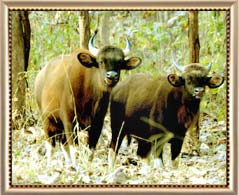Radhanagari dam was completed in 1935 and was built with the support of Shahu Maharaj. After the independence of India, the nearby forest area was converted into “Dajipur Reserve forest” and some tourist facilities sprung up. Dajipur is a small village with about 20- 25 houses that rests approximately 3,000 feet above sea level. The months between September and December are ideal for a visit to this region. The landscape is predominantly rugged and mountainous. The journey up to Dajipur is an exciting one with views of waterfalls from the ghat section. Minds are automatically diverted by the sound of gushing waters, chirping of birds and the sight of trees in full bloom.
There is a resort on the outskirts of the wildlife sanctuary that protects wild bison - The Bison Jungle Resort. The other scenic resorts that are extremely popular among tourists are the backwaters of Radhanagari Dam. The Bison Resort is well known for bison (around 500), which are the tallest and the most splendid of living wild oxen. These animals of 6 ½ feet in height look majestic. Tourists can spot bulls and calves running with their mother or a large herd grazing in the forest, which is a treat to the eyes and one can recall with delight years later. Other animals, sheltered in the sanctuary are leopards (black panthers), sloth bears, wild boars, barking deer, mouse deer, sambar, giant squirrels and wild dogs. The resort has dormitories with beds and it is surrounded by hills on one side and a lake on the other side. After reaching the resort, we were escorted to the sanctuary that has strict security at the gates. In the forest area, we stopped by the Gagangiri Maharaj Tapovan where tribals are trained to make things out of naturally available materials (fruit juices, herbal powders and oils).
As we walked along the trail we came across the Gawakund (‘gawa’ is bison and ‘kund’ is waterhole). It was amazing to see the huge wild bison quenching their thirst at this waterhole. To avoid mishaps, there is a stone tower built from where we can see the animals in their natural surroundings without disturbing them. The sambar kund waterhole for the deer is surrounded by thick herbal foliage and is a source for herbs used in Ayurvedic medicines. There are scenic waterfalls on the steep slopes at regular intervals that add to the beauty of this place.
It was from the sanctuary that one can get a view of the Mohd. Wadi dam, which is one of the highest dams in Maharashtra. There are warnings telling visitors to avoid making fires and setting up camps in the forest due to reptiles and wildcats.
The next morning welcomed us with the sight of the rising sun’s first rays hitting the waters of the lake that created an incredible silver outline for lake. It was a spectacular sight. After spending some time admiring this, we proceeded to Amboli - a hill station about 100 kms south of Dajipur and at 3000 feet above sea level. It is well known for the seven Maratha forts and also for honey. Located at the southern range of the western ghat, the beautiful hill station of Amboli is the last mountain resort after which the plains lead to the beaches. The scenic beauty of the place is simply astounding. There is a place called the Seaview Point and people gather here to watch the beautiful Konkan beach. You can simply while away you time here without a worry in the world.
Amboli is also home to two of the biggest waterfalls in Maharashtra - one which is 9 kms south of Amboli and the other which is 4 kms in the north. Amboli one of the world's "Eco Hot-Spots" and it abounds in a variety of fairly unique flora and fauna. The main attraction for tourists is the numerous waterfalls and mist during the monsoons. There are around 5 decent (and relatively cheap) hotels at Amboli although none of them offer any guided tours into the forests, the main attraction of this hill station.
There are quite a few places of interest here. At Hiranya Keshi you can sit on hours angling for fish or you may even if you please go for a picnic at the Nagatta Falls. We had a wonderful time at the source of Hiranyakesi River, a holy river for the Maharashtrians that flows into the river Krishna. The Shiva temple inside a cave with impressions on the walls is worthy of appreciation too.
Hope you enjoyed reading this as much as I did! :)

No comments:
Post a Comment